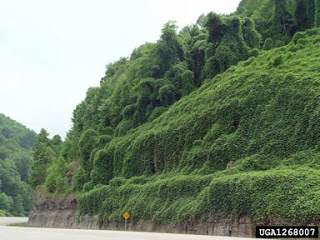 |
| Kudzu |
While we enjoy the spring wildflowers, I hope you all notice some other plants that sprout in spring too – plants we call invasives. Historically, an “invasion” occurs when someone enters a country uninvited, for the purpose of taking it over. Unfortunately, many of our invasives were actually invited in, their use recommended by the US Dept of Agriculture and spread by landscapers. Kudzu is native to Asia and was first introduced into the United States in 1876 at the Philadelphia Centennial Exposition. It was widely planted throughout the eastern United States in an attempt to control erosion. (Oh, I found this photo on the Web, and it was taken in Floyd County, KY.) I searched for a good definition, and found this at Invasive.org:
An invasive species is a non-native species (including seeds, eggs, spores, or other propagules) whose introduction causes or is likely to cause economic harm, environmental harm, or harm to human health. The term “invasive” is used for the most aggressive species. These species grow and reproduce rapidly, causing major disturbance to the areas in which they are present.
- Invasive species, if left uncontrolled, can and will limit land use now and into the future.
- The longer we ignore the problem the harder and more expensive the battle for control will become.
- Invasive species can decrease your ability to enjoy hunting, fishing, camping, hiking, boating and other outdoor recreational activities.
- The United States suffers from $1.1-120 billion per year in economic losses due to exotic, invasive species.
- Approximately 42% of Threatened or Endangered species are at risk due to non-native, invasive species.
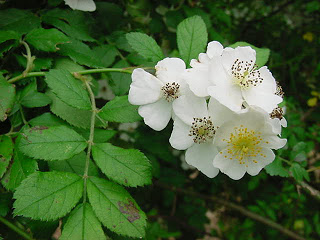 |
| Multiflora Rose |
 |
| Garlic Mustard |
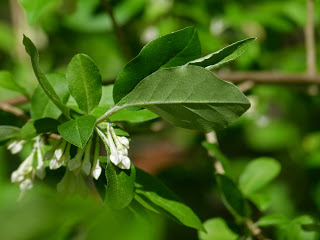 |
| Autumn Olive |
Autumn Olive is a shrub that can grow to 20 feet tall, with silvery undersides on the leaves and small fragrant white blossoms. Fruits are red, juicy, and edible, ripening from September to November. Autumn Olive invades old fields, woodland edges, and other disturbed areas. It can form a dense shrub layer which displaces native species and closes open areas. Autumn Olive is native to China and Japan and was introduced into North America in 1830. Since then, it has been widely planted for wildlife habitat, mine reclamation, and shelterbelts. When the Preserve opened, it was recommended, and now we are trying to get rid of it since it inhibits the growth of native plants. When our Grounds Manager removed a large stand, I went to see what would happen the next spring, and found wonderful growth of native wildflowers which had been waiting for their chance all those years.
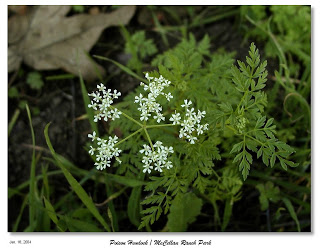 |
| Poison Hemlock Blossom and Leaves |
Watch for a carrot-y looking plants growing along the trails in dense clusters. The blossoms resemble Queen Anne’s Lace (another invasive), and it can grow up to 10 feet tall by summer. One plant can produce over 30,000 seeds. These plants, when eaten, are poisonous to most animals. Poison hemlock is native to Europe and was introduced into North America in the 1800s as an ornamental.
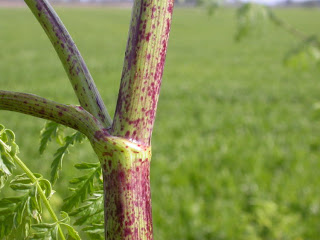 |
| Poison Hemlock Stem |
The Poison Hemlock stems are mottled purple in color, and hollow in the middle. All plant parts are poisonous; however, the seeds contain the highest concentration of poison, highly poisonous alkaloids toxic to all classes of livestock and humans. (It was probably used to poison Socrates in ancient Greece.) Human deaths have occurred from harvesting and consuming the roots as wild carrots or parsnips. It may act as a pioneer species quickly colonizing disturbed sites and displacing natives during early successional areas.
| Winter Creeper |
Winter Creeper (Euonymus) is an evergreen vine that can form a dense ground cover, but also climbs 40-70 feet up a tree, covering the tree and eventually killing it. Flowers are inconspicuous, yellow-green, five petaled and develop in mid-summer. Plants usually only flower when climbing and almost never when trailing along the ground. Fruit are pinkish-red capsules that open to show orange seeds.
| Winter Creeper in Tree |
Winter Creeper aggressively invades open forests, forest margins, and openings. The dense ground cover often resulting from an infestation can displace native understory species and restrict tree seedling establishment. Winter Creeper can also smother and kill shrubs and small trees. Winter Creeper is native to Asia and was first introduced into the United States in 1907 as an ornamental ground cover plant.
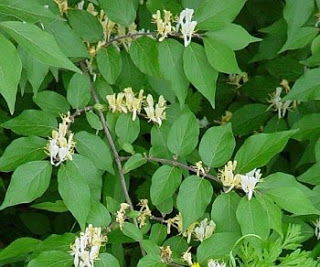 |
| Bush Honeysuckle |
Soon you will notice a wonderful fragrance around the Preserve – Honeysuckle; another highly invasive plant. Often it is one of the first shrubs to leaf out in the spring. The fragrant flowers are tubular, white to yellow in color, thin-petaled and develop in May to June. In September abundant, fleshy berries ripen to red in color and often persist into the winter. Berries are 1/4 in in diameter. Amur honeysuckle readily invades open woodlands, old fields and other disturbed sites.
 |
| Honeysuckle Berries |
It can spread rapidly due to birds and mammals dispersing the seeds and can form a dense understory thicket which restricts native plant growth and tree seedling establishment. Amur honeysuckle is a native of eastern Asia and was first introduced into North America in 1855. It has been planted widely as an ornamental and for wildlife food and cover. It releases a chemical that prohibits the growth of other native plants. There is also a vine Honeysuckle which is an invasive. The native Honeysuckle (yes, there is one) has a red flower that hummingbirds love.
 |
| Japanese Stilt Grass |
I’m sorry to rain on your parade like this. I try to encourage people to get out and enjoy nature, and know it’s depressing to think about invasives. (At least, I find it to be depressing) But you will see these plants at the Preserve. They are difficult to get rid of. Heck, they are almost impossible just to control, let alone eliminate. Think of these plants as bullies. They come up early in the spring and grow quickly, stunting or preventing the growth of other plants that might compete with them. They reproduce profusely. Nothing here eats them, so the only enemy they have are humans, who brought them to begin with. The people who introduced them intended no harm, I’m sure, but they just didn’t think what would happen if these plants escaped cultivation. The story goes on with animals, insects, etc., all of which cause multiple billions of dollars in damage each year. The damage they cause to native plants and animals is incalculable. If you are landscaping this year, ask about using a native plant as an alternative to something foreign. There are several nurseries in the area which promote natives, such as Margaret Shea’s Dropseed Nursery. The presence of these plants makes me enjoy our native wildflowers even more.
